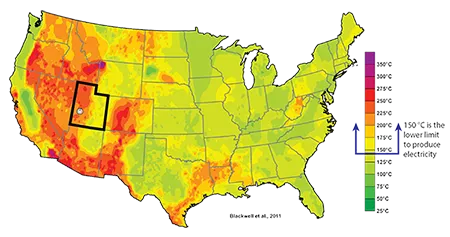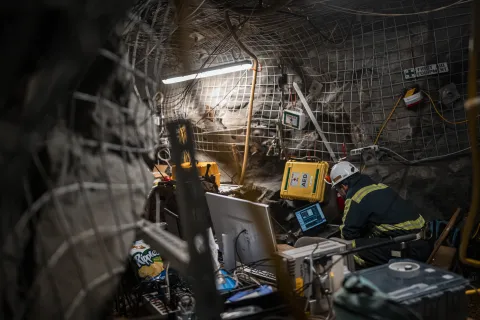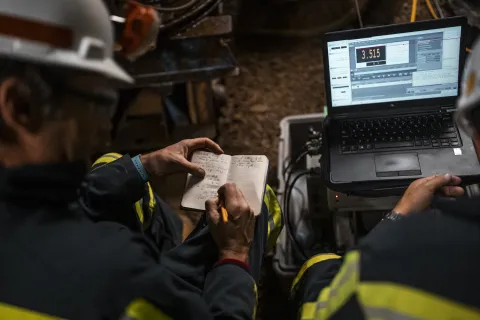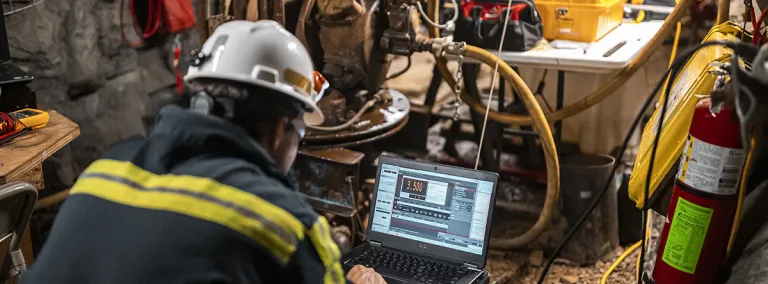Geothermal group takes their research up a level—to the 4100
SIGMA-V experiment moves 750 feet up to learn more about hot rocks 600 miles away
Interstate-80 cuts across the undulating landscape of Utah and Nevada. Along the roadway, mountain ranges with alpine vegetation give way to low desert regions flecked with hunched sagebrush, only to ascend into another isolated mountain range.
The rippling rise and fall of the interstate is caused by fault valleys that run north and south through the Great Basin region. These geologic features, called horsts and grabens (hills and valleys), are the result of crustal extension.
“The whole area has extended, widening hundreds of kilometers over millions of years,” explained Patrick Dobson, geothermal systems program lead and staff scientist at Lawrence Berkeley National Laboratory (Berkeley Lab). With each stretch and tear, the Earth’s crust thins, allowing heat to seep from the Earth’s fiery mantle into the rocks nearer the surface.
Mining heat
Beneath the city of Milford, Utah, the Earth’s crust is especially thin. Just two kilometers below the surface lies hot granite at elevated temperatures of 175 °C. These hot rocks are good news for researchers like Dobson, who are developing technologies to advance geothermal energy systems.
“Geothermal systems are really just trying to mine heat,” Dobson said. “From a geothermal standpoint, higher temperatures at shallower depths are a good thing. We don't have to drill as deep to get the temperatures that we need.”

A site just northeast of Milford is a proposed location for the Department of Energy’s FORGE project (Frontier Observatory for Research in Geothermal Energy). If the project is successful in extracting natural heat, it could act as an enormous, domestic, clean energy resource.
There’s just one problem: the rock near Milford isn’t naturally permeable.
“Geothermal extraction requires three things: hot rock, permeable pathways through the rock and fluid to extract the heat,” explained Tim Kneafsey, principal investigator for the Enhanced Geothermal Systems (EGS) Collab Project and a staff scientist with Berkeley Lab. “Hot rock is an abundant resource in the US, but it is often missing open pathways that allow you to extract the heat.”
The EGS Collab is working to find better ways to extract heat from the earth’s hot rocks. Under the leadership of Berkeley Lab and Sandia National Laboratories, researchers are creating models that can predict the behavior of geothermal hot spots, before full-scale site research begins at the FORGE laboratory in Utah.
“The challenge is to safely and inexpensively create pathways in rocks that will allow us to circulate fluids and extract heat,” Dobson said. “Is it economically viable? Environmentally safe? Technologically feasible?”
These questions brought the EGS Collab to Sanford Underground Research Facility (Sanford Lab).
Taking research up a level
The rocks here aren’t hot, and that’s a good thing.
“It's only about 32 degrees Celsius (90 F) in its native state at this depth,” Dobson said as he placed his hand demonstratively against the rock on the 4100 Level of Sanford Lab. In South Dakota, the Earth’s crust is thick, meaning researchers can access relevant depths and take measurements in situ—research that would be cost-prohibitive at another site.

“At FORGE, they'll be drilling from the surface down several thousand feet deep, with limited direct access to the rock,” Kneafsey said. “Here, we can stand right next to the rock and collect data at depth.”
The EGS Collab has used the underground drifts of Sanford Lab as a research and development testbed since 2015. The SIGMA-V experiment has probed the Poorman rock formation on the 4850 Level for years, collecting immense amounts of data.
Now, the EGS Collab is moving their equipment to the 4100 Level, where the rock is slightly different.
“This rock on the 4100 Level is amphibolite, a metavolcanic rock much more similar to the basement rocks that we expect in the Great Basin,” Dobson said.
“At Sanford Lab, physics experiments and laboratories are concentrated on the 4850 Level, but a large portion of our research community accesses other levels: the biologists, geologists and engineering groups,” said Jaret Heise, science director at Sanford Lab. “EGS Collab’s move to the 4100 Level takes advantage of the tremendous potential our facility offers.”
The testbed on the 4100 Level will focus on hydraulic shearing: opening natural, preexisting fractures in the rock.
“On the 4100 Level, we are trying to reopen existing natural fractures that have been sealed with mineralization,” Kneafsey said. “By opening them and causing them to shift slightly, the roughness of the fractures keeps them propped open. This self-propping allows water to flow through and, in hot rock environments, transfer heat.”
Just as they did on the 4850 Level testbed, researchers will drill multiple boreholes, both to stimulate the rock and to monitor it with a dense array of sensors. Through these boreholes, they can study how fractures open and shift.
Mapping the pathways
To engineer safe and economical geothermal systems at sites like Milford, Utah, researchers have created intricate computer models of the earth’s subsurface.
“A lot of our effort is contributed by people you don't see onsite at Sanford Lab,” Dobson said. “They are working to recreate the physics of the earth using computer models.”
These models predict everything from fluid flow and heat transfer to geomechanical displacement and geochemical reactions between fluids and rocks. The experiments done at Sanford Lab and other test sites help researchers test the accuracy of these models’ predictions.
“We have a world-class team of modelers looking at the data,” Kneafsey said. “Oftentimes when you get real data from real sites, it doesn't exactly fit the preconceived notions of modeling. Every field site helps us validate our models.”

Open science
“We hope that the knowledge and the understanding we generate are very useful for implementing EGS in the future,” Kneafsey said. “We've published over 900 pages of conference papers and journal publications. We are trying to run this project as openly as we can, collaborating and sharing information with other researchers and test sites.”
The EGS Collab includes researchers from nine national labs—LBNL, SNL, Lawrence Livermore National Laboratory, Pacific Northwest National Laboratory, Idaho National Laboratory, Los Alamos National Laboratory, National Renewable Energy Laboratory, National Energy Technology Laboratory, and Oak Ridge National Laboratory; and seven universities—South Dakota School of Mines & Technology, Stanford, University of Wisconsin, University of Oklahoma, Colorado School of Mines, Penn State, and Rice University.
This EGS Collab Project is supported by the U.S. Department of Energy, Geothermal Technologies Office; part of the Office of Energy Efficiency and Renewable Energy (EERE).
